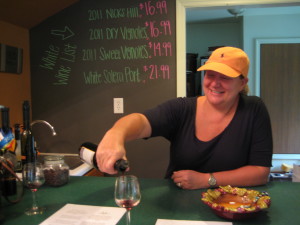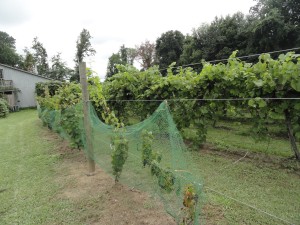2013 Harvest Report: MO, IA, KS, NE, OH
Vineyards across the Midwest are preparing to bring in the last of their grapes. Compared to 2012’s drought and frost affected yields, many vineyards are reporting bigger crops and good quality fruit. However, too much rain has caused problems for some.
Bommarito Estate Almond Tree Winery, New Haven, Missouri
When Midwest Wine Press spoke with Bommarito Estate co-owner and winemaker, Cathy Bommarito-Manley, it was September 3rd and she had just finished picking and crushing their crop of Vignoles with father Nick.
Like many vineyards across the Midwest, drought was the main issue impacting the Bommarito Estate Winery crop last year. In contrast, this season the main problem was too much rain at the beginning of the year. ‘The Vignoles didn’t like all the moisture,” she said. ‘We hit a little bit of black rot issues.” To compensate for the lost crop, they are organizing 2.5 tons worth of extra Vignoles juice from Crown Valley Winery.
The Bommarito Estate has just under 10 acres of grapes. In addition to Vignoles they grow Norton, Chambourcin, St. Vincent, Vidal and Valvin Muscat. The fruit quality of all their other varieties looks great. ‘The Chambourcin, St. Vincent and Norton look fantastic.” By the end of September they’ll have picked the first red varieties. Bommarito-Manley wants to give the Norton more hang time so they will probably wait until the first week of October to pick that.
The quantity of the Bommarito harvest is well up on last year when the drought reduced their total crop to 4 to 5 tons. This year they’re looking at about 20 tons, said Bommarito-Manley. However, only partly because they’ve replanted their Norton vines, that’s still well under their usual haul of about 30 to 32 tons during a good year.
This year Bommarito’s wines have won a swathe of medals including a Double Gold for their 2010 Almond Tree Red (a Norton-St Vincent blend) at the Indy International Competition and an International Silver Medal for their 2011 Vignoles at the Finger Lakes International Competition.
Dale Valley Vineyard & Winery, Stuart, Iowa
At Dale Valley Vineyard & Winery in central Iowa, the five acres of vines were in good shape in mid-September had not experienced the beginning and end of season rain impacting on crop quality in other parts of the Midwest.
Co-owner Tracy Mahlstadt, who started the vineyard in 2001 with husband Ed, said they grow Edelweiss, Foch, Concord and some Catawba and Elvira. Tracy says, compared to last year, there’s a lot more fruit on the vines. ‘Nice and sweet because we let it hang. We’ve got a lot of bees out there right now so obviously it’s ready to harvest.”
‘We’ve already harvested Edelweiss and we’re finishing up harvesting the Concord and everything else this week.” Dale Valley Vineyard expects to harvest about 4 tons of grapes, most of it from their upper vineyard that is mainly Edelweiss and Foch.
Coyote Oaks Vineyard, Salina, Kansas
When MWP spoke to Carlisle Bergquist in very early September he was in the middle of harvesting his Chambourcin grapes. And that was after working his day job as a therapist.
‘I’ve got the first batch on yeast downstairs and I’m going out to harvest the rest of them in the morning,” he said. He expected to get about 80 gallons from their half-acre of mature Chambourcin grapes. Coyote Oaks Vineyard started replanting its vines in 2006 after several years of drought damaged many of their 2000 plantings.
In Salina, Kansas and using environmentally friendly farming techniques, Bergquist and wife Geralyn grow about 5 acres of grapes and also 2 acres of fruit trees for Apple wine. The vineyard includes about an acre each of Chambourcin, Chardonnel, (to be replaced with Cabernet Dore), Crimson-Cabernet, Aphrodite and Cynthiana/Norton.
Bergquist said the Chambourcin harvest is looking good. ‘I’d say 90% of the crop is fully ripened, it’s coming in at about 21 Brix.” Although they’ve had it up to 25 Brix in previous years when it was extremely hot.
The Crimson Cabernet vines are still maturing so they only expect a small amount of juice from those and the year old Aphrodite vines are not yet producing fruit.
This year, rather than drought, their biggest challenge has been controlling the number of grasshoppers. ‘We don’t go in and spray every day, we’re trying to do stuff bio-dynamically.” He said the apple orchard, originally planted in 1980, responded very well to this method. Keep at it Carlisle!
James Arthur Vineyards, Raymond, Nebraska
‘Our numbers are just crazy this year in terms of yield and tonnage,” said James Arthur Vineyards’ winemaker Jim Ballard.
However, there was a price, albeit a small one, to pay: ‘The harvest has kind of kicked my but a little bit, it’s been a tough one,” said Ballard, who took the call from MWP while in the middle of harvesting 21 acres of grapes from their estate and 20 growers. All of their varieties have ripened 2 to 3 weeks later than usual which meant a scramble to find pickers because their usual workforce of high school and college students had gone back to school. The weekend of 20-21st September will see them bring in their late season varieties like St. Vincent and Catawba.
The hard work has been worth it. ‘We have a bumper crop this year, we had record numbers in our Edelweiss.” Edelweiss is their most popular wine and they’ve harvested about 100 tons, including about a third from their own vines. In a more normal year they do up to 70 tons and last year, because of frosts, only 30.
The fruit for both their Edelweiss and Vignoles — they harvested 11 tons, most from their own vines – looks very good too.
‘We had a nice cool Spring, lots of rain when we needed it which I think contributed to us getting the huge crop that we had,” explained Ballard. ‘Then, right before harvest started, we got some heat.” He said the brix were up and the fruit had ripened well.
‘It’s [Vignoles] kind of the closest thing we grow to a vinifera, it’s usually later harvest, little tougher skin, it can yield 3 tons an acre whereas some of these hybrids I can get up to 6, 8, 10 tons an acre.”
From all of their varieties both on and off their estate, including Edelweiss, Vignoles, La Crosse, Concord and Foch they expect to harvest a total of about 240 tons.
Their Edelweiss and Vignoles won awards this year at the Los Angeles International Wine & Spirits Competition and at the Colorado State Fair. Ballard says they make everything from dry to sweet but 70% of what they sell is on the sweeter side. However, his favorite is their dry Vignoles. ‘I think it is a great wine, dry, almost 8 months of oak aging on it.”
Cellar 426 Winery, Ashland, Nebraska
At Cellar 426 Winery, also in Nebraska, the Brianna grapes were harvested on the last weekend of August and like James Arthur Vineyards, the crop was way up from last year.
‘The good news was we ended up with 4 times the volume we had last year,” explained owner Richard Hilske who said they harvested just under 2 tons. The only bad news was gathering up the crop in the 100 degree August heat.
‘The Brianna was excellent,” he continued, ‘and the Frontenac turned out really well too.”
He said yields were up for all their grape types. Hilske and his team grow 5 different varieties on their 2.5 acre estate vineyard and also bring in some juice from local vineyards. Half of their estate vines were planted in 2006 and the rest were planted the following year. The newer vines include Brianna, Marquette, Frontenac, Gris, La Crosse and Chambourcin.
Chambourcin is the last grape that will be harvested during the end of September. In this year’s 2013 Mid-American Wine competition, a Traminette made by Cellar 426 won a Gold Medal.
Buccia Vineyard, Conneaut, NE Ohio
Buccia Vineyard owners, Fred and Joanna Buccia grow 4.5 acres of grapes including Baco Noir, Seyval, Vignoles, Steuben and Agawam. Wet weather has impacted on their harvest.
‘We’ve had a very rainy, wet summer so it’s been kind of a battle,” said Joanna Buccia. However they still expect to harvest enough grapes to make up their usual 3 to 4 thousand gallons of juice.
When Buccia spoke to Midwest Wine Press on 17th September the only grape they’d harvested was Seyval. ‘Seyval grapes, they hold up really well when it’s very humid like it has been and very rainy so they look pretty good,” said Buccia reflectively.
On 28th September they plan to harvest everything else. ‘We do what we call a harvest picnic. We get a group of about 50 customer-volunteer-friends together and everybody picks for 3 or 4 hours and then we put on a picnic. You know, that ‘will work for wine’ thing!” she said laughing. At that point, Baccia will probably sit down to her favorite wine, their dry red made from the Baco grape.








